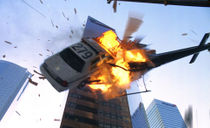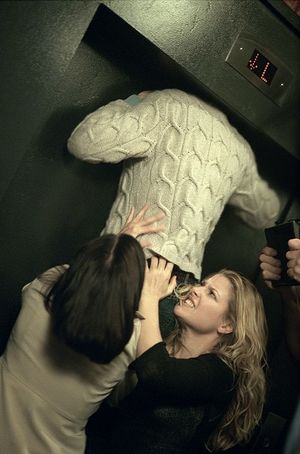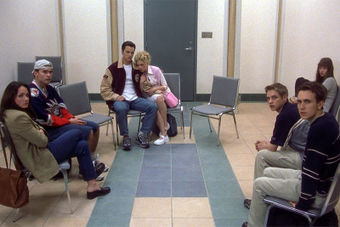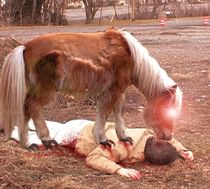Final Destination
“In spite of overwhelming evidence that a gust of wind caused a freak chain reaction involving an easily tip-over-able clothes hanger, a very faulty gas vent and a Metallica poster, the coroner's final cause-of-death ruling is heart attack.”
– A newscaster on another mysterious "accident"
The Final Destination (or God Doesn't Love You: the Movie) films are a series of three four five horror films about the illegal yet hilarious antics of the Grim Reaper. Originally released as a means of making money, the Final Destination films have evolved into something more: a horror franchise with countless sequels. Since entering this waste-paper basket of broken dreams, the Final Destination films have slowly begun to go down in terms of quality and humor. But they will always be available as a last resort for boobs and blood rolled into one, so their considerable fan base of nerds and drunken people will always be satisfied.
Each film is loosely based upon the premise of not dying when you're supposed to. This generally happens to teenagers in the films (after all, what other age group delivers such fun and sexy antics?), therefore the Grim Reaper must extract his revenge immediately. He does so by stalking the teens, watching the females shower and then killing them, hopefully with as much disembowelment as possible. Now, with such a fun concept to use, it could never get stale, right?
__ Right?
Production
It is a little known fact that the Final Destination series started out as a two page The X-Files spec script written by professional screenwriter Jeffrey Reddick. After reading it, X-Files star `1 physically attacked him. Reddick died from his wounds two days later[1], but for some strange reason, movie mogul James Wong picked up on the idea and turned it into a loosely related movie pitch which studio New Line were quick to green-light. Unfortunately, his contract required a responsible adult to be around at all times, and that is how Glen Morgan ended up co-writing.
Wong and Morgan quickly ran into scripting problems. For example, Wong wanted the film to be a gory blaxploitation flick, whereas Morgan preferred a light-hearted buddy comedy. They finally agreed on 'horror'. Another problem was that it was actually hard to think of death scenes. Wong claimed that he left before Final Destination 2 because of that, but returned for 3 because he got jealous.
After five months and multiple trips to A&E, Wong and Morgan finished the script. The next step, however, was finding cheap actors, which James Wong found hard. The role of Alex (who at the time was called Stoney) went through seven different actresses before Wong finally settled on Canadian teen Devon Sawa. The first person to be cast was American Pie star Seann William Scott. Unlike his usual 'partying teen' roles, Scott's character in Final Destination turned out to be something of a nerd and was originally obese. A pay rise and a rapid reworking of the script quickly calmed Scott down. A month later, Tony Todd announced that he had been given the role of a mortician: "I'm going to be in Final Destination. I don't know what it's about and I'm not sure if I want to but I'm doing it."
A casting problem soon arose. In the script, Death was supposed to make three separate appearances, but everyone who auditioned for the role either chickened out due to religious reasons of was deemed 'not evil enough' by Morgan. Wong considered using a fully CGI-made version of Death, but computers back then were not advanced enough to render the Supreme Lord of Darkness. As a result, Death's lines were completely cut from the film, although he makes a brief guest appearance in Final Destination 3.
Popularity
The original Final Destination quickly became a hit. It grossed over $117 million at the box office and received mostly positive reviews, winning Saturn Award for Best Horror Film. Devon Sawa also won the Saturn Award for Best Performance by a Younger Actor, and Ali Larter, the female lead, received the Young Slut Award for a Breakthrough Performance by a Female. This rapid series of awards prompted the studio to make a sequel; this one would be written by David R. Ellis (who would later go on to direct Snakes on a Plane). Final Destination 2: Electric Boogaloo was also a success, making the films, or
franchise as they were now able to be called, a huge hit, prompting a third sequel to be made. Unfortunately, Final Destination III, directed by Wong and written by Wong and Morgan received extremely negative reviews. Critics called it a "stinking pile of shit" (Roger Ebert) and also criticized its many offensive 9/11 references. Wong evidently took no notice of this.
“I'm so proud of this franchise... now, if you'll excuse me, I have some more money to snort.”
– James Wong on Final Destination's success
At this point, the studio had realized the franchise's moneymaking potential, releasing merchandise to go alongside the movies, such as action figures that could be horribly dismembered in the ways portrayed in the films, do-it-yourself kits with which children could enact their favorite deaths on their friends and Death costumes which came with fully functioning scythes. Jack Thompson had much to say about the merchandise, but died in a mysterious car crash soon after.
By the time the third film came out on DVD, no one really liked the franchise any more, despite the second film's gratuitous nipplage. Instead of obeying these criticisms, the studio decided to make a fourth film, entitled Final Destination: Death Trip 3D. At this stage of production, the studio has no real intentions of making the film in 3D. However, returning director David R. Ellis told them to go ahead with it as the script he had written early that morning included all manner of objects, including monkeys, car engines and urine, flying at the screen. Everyone onboard the project was determined that the use of 3D would make up for any shoddy scriptwriting, horrible acting, unfunny jokes and obviously CGI blood, but they were very wrong.
Fans of the series were outraged at the fourth film, having cancelled their Star Trek marathons and World of Warcraft tournaments to watch it, and disappointed at Ellis, whom they had expected to make up for Wong's awful third film. Critics were also disappointed at Ellis, many of them threatening him with death. One critic attempted unsuccessfully to sue producer Craig Perry because of his statement "I wanted [the 3D] to add depth to the film instead of just something popping out at the audience every four minutes", as something popping out at the audience was what the film was mainly made up of. The box office grosses did not echo the public's feelings, as the film made $181,000,000 - the series' highest profit yet.
Further films
As usual, New Line responded to this mainly negative press by announcing a fifth film, also in 3D, soon after the fourth film was released. The fifth film, titled Final Destination 5000 for the time being, was written by Eric Heisserer[2]. Producer Warren Zide said: "Eric is going to, hopefully, break the now obvious repetition of the series with his lightning-sharp writing skills. Well, he said he would. Actually..."[3] Finishing the comment on behalf of Zide, the studio admitted that Heisserer's now finished script did indeed seem a little similar to The Dark Knight. Steven Quale, who had previously worked on films such as Eddie Murphy's The Haunted Mansion, Wear Nothing and Titanic, was hired as the director, most likely because his ego was not yet bloated enough to require a contractual pay rise.
In September 2010, filming began at Lions Gate Bridge in Vancouver, where the opening disaster would take place. Unfortunately, many of the explosives the crew needed to create a realistic bridge collapse were confiscated by the police. With little left to work with, the crew resorted to having the actors wave their arms in the air and run about whilst shaking the camera.[4] Meanwhile, New Line were becoming frugal about the film's publicity. Only two trailers and a selection of posters were released, none of which echoed the plot line or live action of the film. The film was be released on 12 August 2011, on the birthday of Quale, to a mild box office success and mixed reviews.
Tony Todd has claimed, much to the dismay of the fans, that if the film is successful, two more will be filmed back to back. Even though no one has yet backed this statement it has left a disappointing outlook for the films. Producers of the series are already guessing that fans are pooling their money in order to buy advance tickets to the premieres of the next six to seven installments.
Characters
The series (or at least some of it) prides itself on its realistic, well developed characters. Even critics have mentioned them as a strong point in their reviews, with Roger Ebert saying "...this bland, putrid, outlandish output of hollow, unemphatic teenagers made me cheer for the anonymous "Death" character, who, ironically, was the most fleshed out."
The person who has the premonition in each film is the one audiences are made to like. In the first film, this was Alex Brownie, a teenager who has fun building models of fishing rods. Alex is something of a loner, always running off when other humans are less than half a meter away from him. Facing his agoraphobia also becomes a key plot point as the first film plays out.
During the writing and rewriting of Final Destination, Alex was given a "girlfriend", Clear Rivers. She is like Alex in a way, as people see her as sly and mysterious. Her mother died during childbirth and her father was shot in a 7-Eleven Store a few years later, making her an orphan. In Final Destination, she is the only person that believes Alex when he begins to rant about Death, suggesting a lack of intelligence. Clear was the only person to make it through to the second film, in which she is blown to pieces. Although it is never made explicitly clear that they liked each other,[5] Alex and Clear became, debatably, the only likeable couple in the series. Clear also appeared on an estimated 30% of all manufactured Final Destination shirts.
Despite Clear's actress's high pay, the main character in Final Destination 2 was actually Kimberly Corman, who has a premonition of a horrific highway pileup during a routine visit to her jailed father. Kimberly's character is not very developed, although she blames herself for her mother's death (as she 'accidentally' kicked her off the side of a bridge). Halfway through the film, she enlists the help of Clear Rivers in order to cheat Death, however as soon as their contract expires, both Clear and Kimberly are killed.
In Final Destination 3, all links to the previous two films were destroyed and a girl named Wendy was made the
lead. She, like the others, is a teenager and is of Pennsylvanian descent. She is the first lead in the series that is not perpetually depressed, and producer Craig Perry tweeted in 2006 that she has had a history of drug use.
Final Destination 3 marked the addition of somewhat wacky comic stereotypes into the series: the annoying pervert, the cheerleaders slash best friends, the slightly psycho goth, the goofy racist sheriff. Some people believe that as they were well used stereotypes, Wong (the director) felt that the public would already be familiar with them, and hence would not need to expand on them. He was clearly forgetting the rule which made the first two films mediocre rather that bat-shit terrible.
The fourth film also forgot the rule, giving way to a host of expendable teenage personalities. They were led by Nick O'Bannon, whose emotional range fluctuates from mildly shocked to mildly bored. Nick overrates himself and believes that he is a hero. This was subtly implied when an alternate ending, featuring Nick sacrificing himself, was cut out.
The fifth film's trailer promises every character to have a funky hipster accent and a rapist's sense of humor. No one is yet sure if this is good or bad.
Themes

Before the inclusion of 3D and sub-machine guns, the series carried mildly comic and subtle themes about death. James Wong claims that this was to "explore our worries and please the critics". The philosophical core of the first film is essentially about dying itself, and also premonitions, intervention and, ultimately, whether it is worth it trying to escape death as it is naturally inevitable.[6] Also present was the well-hidden notion of the events of the film symbolizing growing maturity to the point of death, shown through the increasingly graphic "S&M" scenes. The studio often denies the potential perversity of this.
All of these themes are (apparently) present in Final Destination 2, and all shown through the characters dying. Final Destination 2 had also "broadened the franchise's horizons" to include a vast range of other thoughtful topics, for example: if drugs are right, if being openly gay is right and the probability of having a heart attack whilst watching pornography. Such deep ideas were often mentioned by the critics as "borderline legit" and "genuinely interesting, but mainly because of my bribe".
Final Destination 3, however, abandoned this philosophical depth in favor of overblown sex scenes and an increased rate of two death scenes per minute. Final Destination 4 and 5 both followed that path, although all three of the "shitty" sequels take time to frequently and unsubtly explore the decaying quality of sequels to good films, albeit unintentionally.
Spin-offs
Most likely due to its money-making reputation, the Final Destination series has received several spin-offs, namely a series of comics, a series of novels, a series of unfortunate events and an animated TV show. The books were released by company Black Flame throughout 2005, with nine in total published. The first is called Dead Reckoning and revolves around an emo porn star named Jessica Golden (see?) who throws herself and several others out of strip club 'Club Pussy' mere hours before it collapses into a pile of gore and severed genitalia. Naturally, Death picks off the survivors in a fashion similar to that of the films but slightly adapted towards the needs of a format that relies on the imagination of the reader. Set in LA, the second novel (Destination Zero) follows Patti Fuller, who survives a train bombing only to be shot down by the Grim Reaper wearing an FBI suit. It gained some recognition as being the shortest book ever published by Black Flame at only six pages long, but was quickly beaten by the multi-award winning Mouse's Day Out. End of the Line entwines romance and horror as twins Danny and Louis King, two brothers who have shared a premonition and saved survivors both attempt to win the heart of a woman who is doing Death's dirty work. The series' original comedy horror theme returned in Dead Man's Hand, in which a man must stop an elevator he dreams about from crashing before it falls on top of him. The next novel, Looks Could Kill, is about a disfigured female model who asks Death for her beauty back in exchange for the lives of her friends, however Death replies "What a bitch!". After Looks Could Kill, novelizations of the first three films were released, followed by Death of the Senses in mid-2006. It is about a homeless man who saves a policewoman from a serial killer, only to find out that the killer had six other victims.[7]
Zenescope Entertainment published the first official[8] Final Destination comic in 2006. It is called Sacrifice and tells the story of a Mayan who has a premonition of the Spanish defeating his civilization. A miniseries made up of five issues was later released, again by Zenoscope. Named Spring Break, it is about a group who get trapped in Cancún, Mexico after surviving a hotel fire. It retained an overall feeling of farce, relying heavily on irony and sexual humor.
An animated series, aimed mainly at eleven to fourteen year olds, was aired on Cartoon Network during spring 2008. It was made up of eight fifteen minute episodes. Due to the show's restrained running time and the fact that the main characters changed every episode, many of the deaths happened in rapid succession, giving the show a subtle sense of black humor which helped earn it a small cult following. As the show was for kids, the deaths were mostly off-screen. Several weren't, but accompanied slapstick humor to the point of only being mildly disturbing. A box set was released in 2009.
Final Fantasy
Wait, what are we talking about again?
See also
References
- ↑ Lawsuits against Duchovny were suggested but dropped in favor of free X-Files posters.
- ↑ Heisserer also wrote A Nightmare on Elm Street, however it is unclear whether he wrote the original 1984 film (directed and written by Wes Craven) or the negatively received 2010 remake.
- ↑ At this point Zide rushed from the pool to his mansion, shutting the door behind him.
- ↑ Source: A 30-year-old passerby.
- ↑ It was made painfully clear in the original ending, which featured Alex impregnating Clear, although it was disliked by test audiences and therefore forgotten about.
- ↑ Several Harry Potter fans and asylum patients beg to differ.
- ↑ Book synopses courtesy of Wikipedia.
- ↑ Many unofficial comics had been made by the loving 'fans', who liked to include Star Trek references in every panel.







